|
Dispilio Neolithic Lake Settlement
The prehistoric settlement of Dispilio is situated on the southern shore of Kastoria lake, Orestiada, at the site Nissi (=island). It was located in 1932, when the lake level fell. |
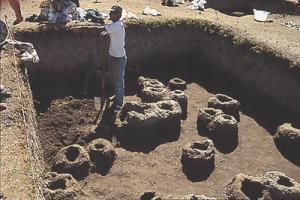 Systematic excavations (1992 onward) unearthed the remains of a large lakeside settlement of the Late Neolithic period; one of the most important and oldest of its kind in Europe. Excavations at Dispilio constitute a landmark for archaeological investigations in Greece because of the special character of the site and because it permits the study of habitation structures during the Neolithic Period.
The houses of the settlement, circular and rectangular, were built of timber, reed, and clay upon timber-post framed platforms. The modern reconstruction of the lakeside settlement provides a wonderful insight into the habitation norms of that period.
Among the fauna and flora remains, as well as the mobiliary finds from the excavations (pottery, tools, etc.), the whole range of economic activities of the prehistoric inhabitants of Dispilio are represented: farming, animal husbandry, hunting and fishing. Numerous bone hooks and traces of a boat, identical to those used to this day by the fishermen of Kastoria, is clear evidence that fishing was practised. Finds, such as leaf-shaped and triangular arrowheads of Melian obsidian, pottery similar to that of the neighboring Balkan areas, and a stone ring idol pendant, place the settlement of Dispilio within the exchange networks developed in Greece in particular during the Late Neolithic period.
Grey pottery of the Tsangli type, black burnished ware of the Larisa type, and polychrome-painted vessels date to the phases of the Late Neolithic I. In the late phases of the settlement, black and blacktopped ware predominated, as well as red burnished and painted designs (brown on a light background). Characteristic types of vases were bowls, fruit stands, closed vases with a neck, and clay tables.
The community at Dispilio must have been a culturally evolved one, as is indicated by the three bone flutes, along with a wooden tablet with incised linear symbols that archaeologists were happy to unearth (please see our album). This tablet dates with certainty from 5260 BC, and is probable to be an early form of written speech, as has been assumed about similar symbols on clay, discovered at settlements in the southern Balkans (Vinca culture).
(Based on repeated visits at the spot and info from www.fhw.gr/chronos ) |
(Photos: Michael Tziotis)
Click on any of the pictures to enlarge.

Dispilio: Panoramic View of the Settlement
The photographer believes that this photo is second best only to being there! |
|
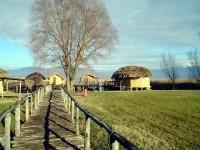
Dispilio Settlement: Entrance Pathway
Approaching through a pathway made with tree trunks. |
|
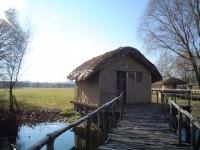
Dispilio Settlement: Lakeside Huts
This hut is built precisely on the edge of the lake, on solid earth, by the wooden drawbridge. This was possible only at a later stage, when wall construction was more elaborate and immediate danger from attacking animals was minimized. In case of emergency, people turned for shelter to the part of the settlement on poles, and the bridge was raised. |
|
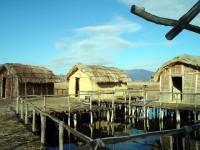
Dispilio Settlement: Neolithic Hut Reconstruction
Huts sitting on poles in the lake, considered to be older than the ones on solid soil, provided better protection against wild animals, especially after lifting up a suspendable bridge-like wooden pathway. |
|
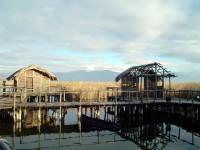
Dispilio Lakeside Settlement
To the right, a half-finished hut to exhibit the way pieces of timber were interwoven to produce the hut skeleton. |
|
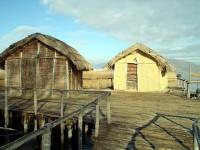
Dispilio Settlement
Two huts at two different stages of building skills, without and with whitewashing, using mud from the lake sediments, mixed with reed to improve its durability |
|
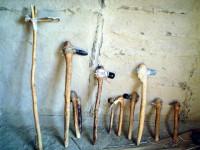
Dispilio Settlement: A collection of farming or wood-cutting tools with stone edges.
Some of these pieces of stone are of Melian obsidian. This is proof of well developed exchange networks in the southern Balkans during the late Neolithic Era. |
|
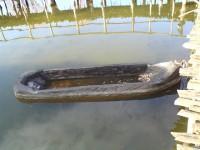
Dispilio Settlement: Boat Reconstruction
A single receptacle flat-bottomed boat, of similar construction to the bigger, three-receptacle ones, in the other boat photo. |
|
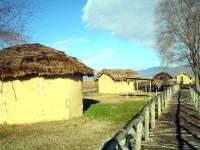
Dispilio Settlement: Entrance to the Reconstructed Neolithic Village
Approaching the settlement showing three stages of its evolution: round lakeside huts, rectangular waterline constructions, and in-lake huts sitting on wooden poles. |
|
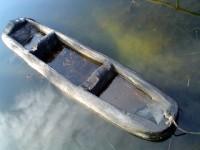
Dispilio Settlement: Fishing Boat
Flat-bottomed boats, produced by digging seats in a single tree trunk, formed in a very similar way as the local fishing boats used on Orestiada Lake even today. |
|
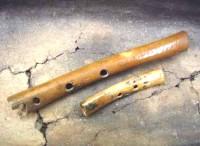
Dispilio Settlement: Neolithic Flutes
Neolithic civilization did have its feasting times! One of the three bone flutes found during the excavations. This flute has 5 holes of equal diameter (4 to the front + 1 at the back side)
credit: dispilio.org |
|
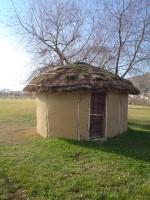
Dispilio Settlement: Rounded Hut Reconstruction
Eventually, as people felt more secure, more in control of their natural environment, huts were built in the proximity of the lake, rounded and whitewashed on both sides of their walls for both added durability and better insulation against the cold. |
|
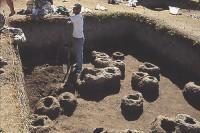
Dispilio Settlement: Stone bases for Wooden Poles
Wooden poles were secured in place with these specially prepared pieces of stone resting on the lake's bottom.
credit: Hellenic Ministry of Culture/ARF |
|
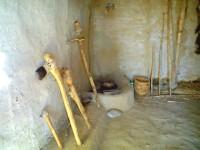
Dispilio Settlement: The farmer's hut
The interior of the farmer's hut, showing replicas of farming stone and bone tools. |
|
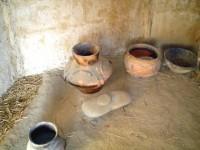
Dispilio Settlement: The farmer's hut.
The farmer's hut interior showing ornated clay pots for grains and a primitive stone mill to produce flour. |
|
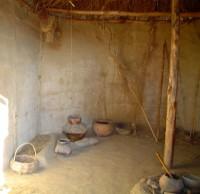
Dispilio Settlement: The Fisherman's Hut
The fisherman's hut interior; bone hooks and fishing nets and equipment. Remains of flat-bottomed boats (see relevant photo) add to our conviction that fishing was well developed. |
|
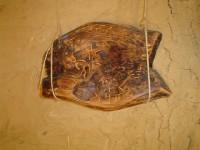
Dispilio Tablet
This tablet dates with certainty from 5260 BC. and is not unlikely to be an early form of written speech, as has been assumed about similar symbols incised on clay, discovered at the Vinca culture settlements in the southern Balkans. If it is proved so, the beginning of writing goes back in time two thousand years at least! |
|
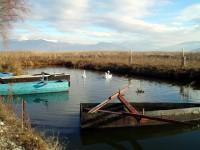
Dispilio Wildlife
Minding their own business, unaware of the fact that they are enjoying the same spot of the lake prehistoric man did 7000 years ago. The reconstructed settlement is 20 meters (600 feet) to the left. |
|
|
|
|
|



